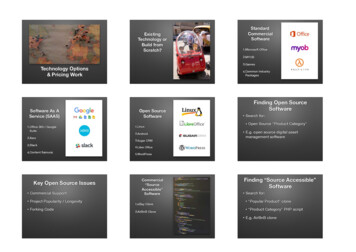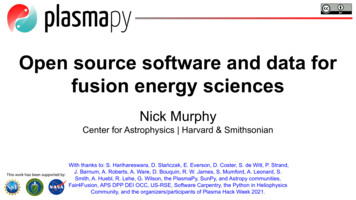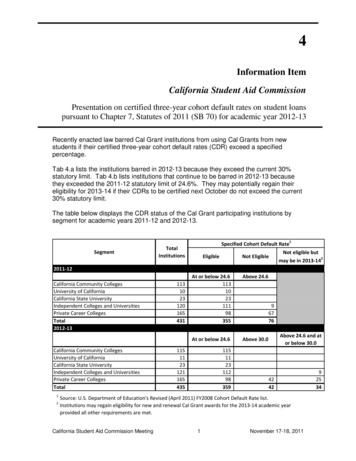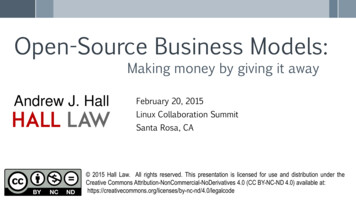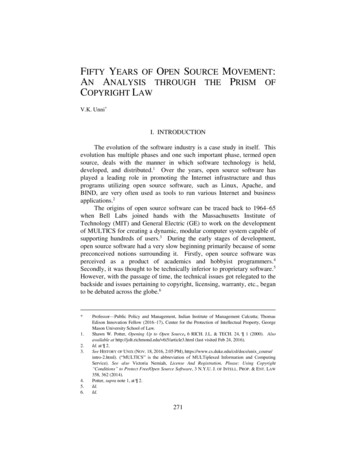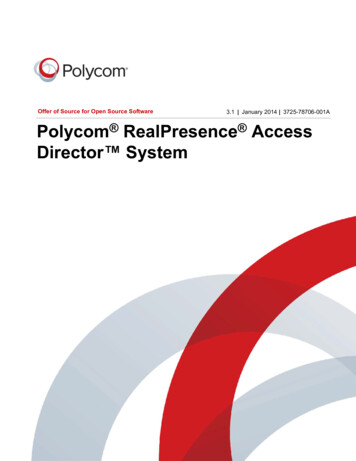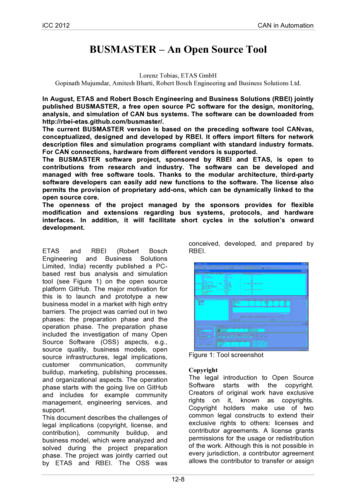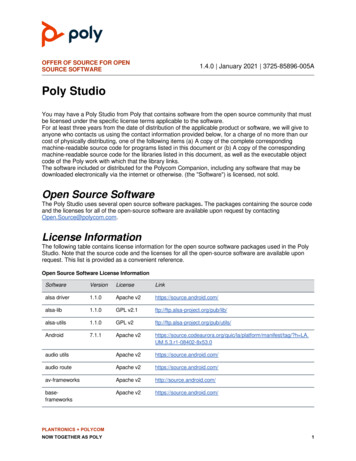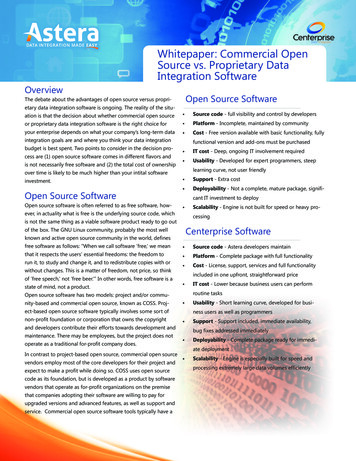
Transcription
Whitepaper: Commercial OpenSource vs. Proprietary DataIntegration SoftwareOverviewOpen Source SoftwareThe debate about the advantages of open source versus proprietary data integration software is ongoing. The reality of the situation is that the decision about whether commercial open source Source code - full visibility and control by developersor proprietary data integration software is the right choice for Platform - Incomplete, maintained by communityyour enterprise depends on what your company’s long-term data Cost - Free version available with basic functionality, fullyintegration goals are and where you think your data integrationbudget is best spent. Two points to consider in the decision process are (1) open source software comes in different flavors andis not necessarily free software and (2) the total cost of ownershipover time is likely to be much higher than your intital softwareinvestment.Open Source SoftwareOpen source software is often referred to as free software, however, in actuality what is free is the underlying source code, whichfunctional version and add-ons must be purchased IT cost - Deep, ongoing IT involvement required Usability - Developed for expert programmers, steeplearning curve, not user friendly Support - Extra cost Deployability - Not a complete, mature package, significant IT investment to deploy Scalability - Engine is not built for speed or heavy processingis not the same thing as a viable software product ready to go outCenterprise Softwareof the box. The GNU Linux community, probably the most wellknown and active open source community in the world, definesfree software as follows: “When we call software ‘free,’ we mean Source code - Astera developers maintainthat it respects the users’ essential freedoms: the freedom to Platform - Complete package with full functionality Cost - License, support, services and full functionalityrun it, to study and change it, and to redistribute copies with orwithout changes. This is a matter of freedom, not price, so thinkof ‘free speech,’ not ‘free beer.’” In other words, free software is astate of mind, not a product.included in one upfront, straightforward price routine tasksOpen source software has two models: project and/or community-based and commercial open source, known as COSS. Proj- ect-based open source software typically involves some sort ofnon-profit foundation or corporation that owns the copyrightand developers contribute their efforts towards development andmaintenance. There may be employees, but the project does notoperate as a traditional for-profit company does.In contrast to project-based open source, commercial open sourcevendors employ most of the core developers for their project andexpect to make a profit while doing so. COSS uses open sourcecode as its foundation, but is developed as a product by softwarevendors that operate as for-profit organizations on the premisethat companies adopting their software are willing to pay forupgraded versions and advanced features, as well as support andservice. Commercial open source software tools typically have aIT cost - Lower because business users can performUsability - Short learning curve, developed for business users as well as programmers Support - Support included, immediate availability,bug fixes addressed immediately Deployability - Complete package ready for immediate deployment Scalability - Engine is especially built for speed andprocessing extremely large data volumes efficiently
free version with basic functionality and a more feature-rich version that is commercially licensed and must be purchased, just like proprietary software. Because the source code is open, COSS enables more and deeper interaction between the community of customersand developers, making the commercial open source model more user-focused than proprietary software vendors.Proprietary SoftwareProprietary software is software that is the intellectual property of the developer(s), the source code for which is closed and proprietary.The source code is built into a complete platform that is sold as a commercial product and licensed to users for a fee. Proprietary software is a mature, full-featured product ready to be deployed and used, and it comes with support and service.Why Pay For Software When You Can Get It Free?Data integration proprietary software licenses require hefty upfront fees—so why would an enterprise pay for proprietary licenses whenopen source software is available for free? This whitepaper explores the advantages and disadvantages of both open source softwareand proprietary commercial software, and which solution is the better choice for different scenarios.Open Source Software AdvantagesSource Code ControlOpen source software permits programmers to have full visibility of the source code and manipulate the code however they please. Italso enables programmers to customize the software to fit particular needs.CostOpen source code is free to download, use and manipulate. Developers can do anything they want with it, including integrating it into aplatform that can be sold commercially.CommunitySoftware updates, bug fixes, and enhancements are available through a community of developers and customers behind the opensource software who review and improve the code, making this model more user-focused. The degree of advantage is based on theactivity of the community. The more active the community is, the better the software is. In the case of open source data integrationsoftware, the community is quite small.Open Source Software DisadvantagesIncompleteFree open source software has not been developed as a commercial product and therefore is usually immature and incomplete, thepremise being that the community will add to it over time. That scenario is too limited for many real-life situations, often requiringupgrading to a more robust, feature-rich version down the line. That version is commercially licensed and must be purchased, just likeproprietary software.Bug fixesOpen source software suffers from the same issues as proprietary software—it comes with bugs. With open source code, however, theonly way for companies to work around or fix the bug is to either invest the time to figure it out themselves, get help from the community, or invest in third-party support. With open source code, dedicated customer support either does not exist, or, if it does, it can costas much as a license for commercial software throughout the life of a data integration project.Availability of SupportSupport is not included in the free download of open source code. It is an additional cost, often more expensive than support for acommercial product, where it is bundled with the upfront purchase. In order to get support for different aspects of a project, data analysts/programmers may have to investigate several different sources and experience significant down time while waiting for responsesand help.TrainingSince open source code is not a commercial product, training is also not included with your free download. If it exists at all, training, likesupport, is an expensive add-on. Data integration is particularly intricate software with a steep learning curve and event experienceddevelopers usually need training on best practices, as well as consulting services on how to customize it to work best for their particular
scenarios.UsabilityOpen source software is typically much more complex and less mature than proprietary software, having been developed for a highlyskilled community of users, not for commercial use. It requires a steep learning curve for the enterprise IT team responsible for implementing the downloaded code and is much too complicated for everyday business users to work with.Proprietary Software AdvantagesMaturityCommercially developed proprietary software is mature and full featured. Once purchased and downloaded, it is ready for immediatedeployment.SupportCommercial software comes with a strong support team from the company that developed the software. Support personnel are available immediately and know and understand every nuance of the product. They are trained to provide targeted help and answers quicklyand efficiently. Users do not have to rely on the community for help or use expensive third-party or add-on support.Training and ConsultingProprietary software companies provide training and consulting specifically developed for their product. While these services are alsoadditional expenses, they are usually significantly cheaper than open source services and they have been developed specifically to provide customer satisfaction and get the user up and running fast.Superior FeaturesCommercial software is more mature and full featured out of the gate. Open source code improves over its lifecycle because the expectation is that the community will make it better over the long haul.OwnershipThe company purchasing the software owns a license that entitles it to everything the software vendor offers in regards to that product,including updates, bug fixes, and new versions.UsabilityUnlike open source software, proprietary software has been developed with the end user in mind, so it is typically easier to use and canbe used by a broader community than just developers and programmers. Usability is particularly important for data integration software because the shorter the learning curve and the broader the user base is, the more quickly projects can be completed. Additionally,software that can be used by business users as well as developers saves on IT costs and enables IT to deploy in other areas where theirexpertise is needed.Proprietary Software DisadvantagesLack of visibility into source codeThe company purchasing proprietary software does not get control of the source code. Users are dependent on the vendor’s decisionsfor any modifications and enhancements. Some proprietary software comes with software design kits for extending and customizing thesoftware, but users are limited to the areas of the product that are intended to be customized.PaymentBecause proprietary software must be paid for up front, there is always a risk the product will not meet the needs of the purchasingcompany as expected. However, the success of commercial software companies depends on well satisfied, long-term customers, so it isin their best interest to provide well developed customer support, training, and consulting to work out problems with the software andensure that the purchasing company is satisfied. In addition, most data integration software companies provide free software demosand proofs of concept, as well as limited trial licenses, to enable the purchaser to ensure the software is the right fit.
Which type of data integration software is the right choice for you?Open source and proprietary software each have advantages and disadvantages, and the choice as to which one is right for your company depends on the priority of the goals you have for your software integration projects and what tradeoffs you are willing to make.While open source data integration tools have matured considerably in the past several years, on a feature-by-feature comparison, theystill can’t match the leading commercial offerings. A leading analyst firm stated in a research paper that open source adoption increasesbecause it is often considered “good enough.”1 In an article in the New York Times entitled, “Open Source and the Challenge of MakingMoney,” open source software vendors discuss that they offer open source software to get a project going, and then internally developapplications for upsale that “actually make the source project useful.”2If your IT staff is robust enough to tackle with little or no support or training third party written code that is “good enough” but possiblynot yet “useful” and effectively speak to the community of developers for bug fixes and updates, then open source is an economicaloption. Keep these mitigating factors in mind: Cost of support - While the software is free, any outside support and training that is required will be expensive, both in termsof fees and in down time waiting for community help Time to market - It will take longer to implement the less well-developed open source software, so if project completion timeis a factor, you should consider your time-to-market tradeoff for upfront purchase expense IT cost - There will be extra cost involved in paying for your IT staff’s time to learn the more complex software and find community support resources should you choose not to pay for vendor support services User base - Your user base will always be limited to experienced developers who know how to work with source code, do theirown programming, and interact with the developer community. This means higher IT costs and longer project completiontimes due to fewer contributors.On the other hand, if you have large, complex data integration projects and/or need to complete your project quickly and within a budget, a more mature, ready-to-go commercial software option is the better choice. While you’ll have to pay an expensive licensing fee upfront, you’ll save costs downstream for these reasons: Your IT staff can immediately start the project with a ready-to-go platform and dedicated support, training, and consultingresources The working model can be handed to business users so a broader base of workers can complete the project faster at a lowerhuman resource cost Your time to market will be faster because your projects will be completed soonerA contributed article in Forbes Magazine, “The Hidden Cost of Free,” summarizes the difference: “Think of commercial software as ahouse and open source software as everything you need to build a house — raw lumber, nails, sheet rock, windows, plumbing fixturesand the rest. You can spend your money and buy the house, or you can spend your time and build the house. Either way, you pay foryour house.”3Total Cost of OwnershipWhen evaluating the right software choice for your company, it is important to consider the metrics of total cost of ownership (TCO).Overall, TCO for free commercial open source data integration software can be significantly higher than the upfront cost of commercialsoftware licenses for several reasons. Commercial open source solutions require high levels of software development expertise and significant learning curves, and are often restricted in their ability to scale or adapt to enterprise-grade demands. Moreover, many commercial open source free alternatives are basic packages that require manual configuration, lack necessary features, or otherwise fail to meetkey requirements for a truly purpose-built data integration architecture. Finally, you must consider the business risk if the project fails.References1etltool.com, es, open-source-software-the-hidden-cost-of-free/3New York Times Bits, ce-and-the-challenge-of-making-money/
Centerprise SolutionsDataWarehousingCDCHigh-performance data warehousing ETL features ina unified, intuitive environment.Data MappingChoose either a batch or real-time change data capture strategy for your particular requirements.ETLTransforms advanced mapping, validating, and cleansingtasks into basic drag-and-drop or single-click commands.Data ConversionExtract data from any source, transform it to suit yourneeds, and load it into your database or warehouse.Data IntegrationComplex doesn't need to be complicated. Visual, code-freeparsing, transforming, and loading of data from any source.Data MigrationA single platform for complex, hierarchical integration the requires no coding.EDIUnique hierarchical data processing technologiesautomate and streamline data migration projects.Full electronic data interchange functionality combinedwith Centerprise complex data mapping capabilities.www.astera.comContact us for more information or to request a free trialsales @astera.com8888-77-ASTERA Copyright 2014 Astera Software Incorporated. All rights reserved. Astera and Centerprise are registered trademarks ofAstera Software Incorporated in the United States and / or other countries.Other marks are the property of their respective owners.
activity of the community. The more active the community is, the better the software is. In the case of open source data integration software, the community is quite small. Open Source Software Disadvantages Incomplete Free open source software has not been developed as a commercial product and therefore is usually immature and incomplete, the
